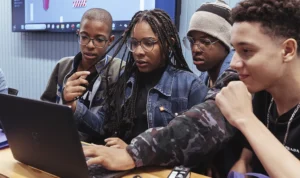Quotas for public school students, black and indigenous people in higher education and job market, minimum percentage of women candidates in political parties, socio-social assistance to the LGBTQIA+ public, income transfer programs are some examples of affirmative action in practice.
Understand what affirmative actions are, how they work and what they are for and how affirmative action policies have developed in Brazil and around the world in recent decades.
What is affirmative action?
Affirmative action is an instrument of public or private policies – resources or special rights – for reparation, inclusion and protection of citizens socially excluded because of color, gender, religion, age, physical disability or socioeconomic condition.
The objective of affirmative actions is to eliminate historical inequalities and repair social and economic losses caused by the discrimination and marginalization suffered over the years by people belonging to these social groups, consolidating the welfare state.
Quotas in universities are the best-known form of affirmative action. But there are other modalities, ranging from low-interest loans, scholarships and student assistance programs to income transfer programs.
Political participation, health services, business opportunities, social protection networks and cultural and historical recognition are also considered affirmative actions.
How important is affirmative action?
Affirmative actions are an important instrument to reduce inequalities historically imposed on certain social groups, inserting their population into the job market, academic and political environment through quotas at universities, reservation of places in public competitions and income transfer. between others
Of the inclusion mechanisms of affirmative action policies, ensuring access to higher education for the black, indigenous and low-income population has been one of the most important in recent years in Brazil.
To better understand how important quotas at public universities are, just remember that many of the first quota holders, in the early 2000s, were also the first members of their family to attend higher education.
The percentage of quota students jumped from 13% to more than 39% between 2012 and 2017, according to data of the Higher Education Census (CES) for the year 2017.
And data from the Brazilian Institute of Geography and Statistics (IBGE) show that the percentage of black and mixed-race people who completed their degree grew from 2.2%, in 2000, to 9.3% in 2017.
Affirmative action policies: what are they?
Affirmative action policies can be governmental and state-owned – public policies – or private initiatives. In both cases, they aim to correct social demands.
Both public policies and private affirmative action initiatives (from NGOs, religious institutions, political parties) are focused, temporary and palliative. In other words, they carry out the transformation of a specific social demand in a certain period of time, but without solving all the problems that arise from this demand.
Of a social, economic, cultural, racial or ethnic nature, public affirmative action policies are divided into quotas or reservation of places in universities, competitions and private companies, bonuses or investment funds, scholarships, income transfer programs and educational campaigns and actions.
Affirmative action around the world
India, the United States and South Africa are pioneering countries in adopting affirmative action policies around the world. Demands for affirmative action, such as quotas, arose at times when there were no universal laws of racial and social equality.
Other countries, such as Denmark, Norway and Italy, have been adopting public affirmative action policies over the last 40 years to reduce gender and ethnic minority inequality.
The formation of the modern Indian State in the 1950s, the North American civil rights movement in the 1960s, and the drafting of the post-apartheid South African Constitution in the 1990s were milestones in the development of action policies affirmative in these countries.
The term affirmative action appears in the United States for the first time in 1965, when John Kennedy's government created a set of laws and measures to promote equal rights between blacks and whites.
Among Spanish-speaking Latin American countries, Colombia was one of the first to adopt the affirmative action policy, in the 90s, with access programs to higher education for the Afro-Colombian community.
Affirmative action in Brazil
The affirmative action policy in Brazil began with the 1988 Constitution, or Citizen Constitution, which provided for a reservation of vacancies in the job market for people with physical and mental disabilities.
With redemocratization, social movements, such as the black, land and feminist movements, began to have more space and dialogue, expanding their fields of political action.
In 2001, the State University of Rio de Janeiro (Uerj) implemented the quota system in higher education. In 2003, the Universidad de Brasília (UnB) was the first federal institution to officially opt for a system to reserve places for black people.
The Law of Social and Racial Quotas for all universities in the country was established in 2012, and in 2014, for public competitions.
People identified by the LGBTQIA+ movement (Lesbian, Gay, Bisexual, Transsexual, Queer, Intersexual and Asexual) have the right to use the social name guaranteed by presidential decree.
Other affirmative actions aimed at this public are the recognition of same-sex marriage and the criminalization of homophobia and transphobia.
Affirmative Action Programs
Affirmative action programs include quotas supported by law for low-income people, black, mixed-race and indigenous people and people with physical and mental disabilities in higher education and the job market.
In addition to these, there is also a quota of 30% for feminist candidates in elections and 30% for the electoral and party fund to finance female candidates.
Also part of affirmative action policies are income transfer programs, such as Bolsa Família, bonuses and salary allowances, such as PIS (Social Integration Program), scholarships, government programs, such as the National Human Rights Program and the University for All Program (ProUNi).
Multiculturalism, intellectuality and affirmative action: understand this connection
The inclusion of students, through affirmative action, from different realities and social classes than those traditionally present in higher education has enabled multiculturalism and new faces of intellectuality in the Brazilian academic environment over the last 20 years.
Plurality of thought, research and focus gained space in universities, helping to expand the debate on racial and gender issues in these institutions.
In addition to enriching academic thinking, plurality in higher education also brought the professional and intellectual qualification of excluded social groups and the politicization of university spaces, a greater debate.


